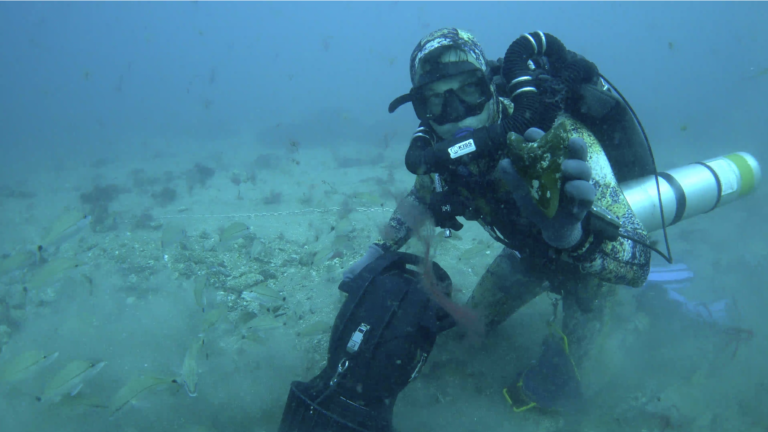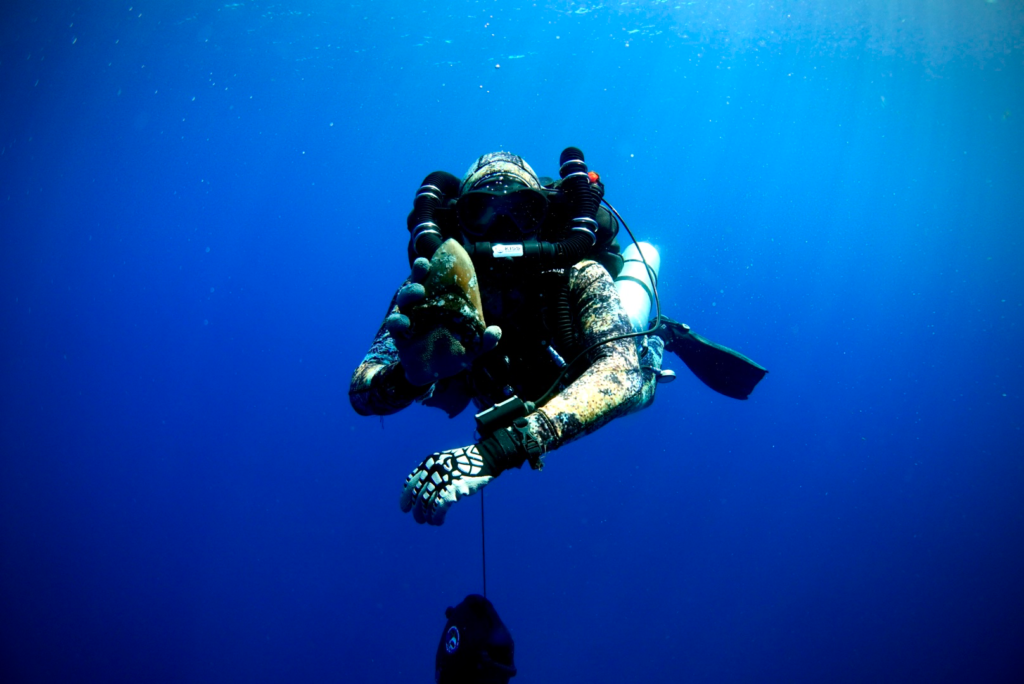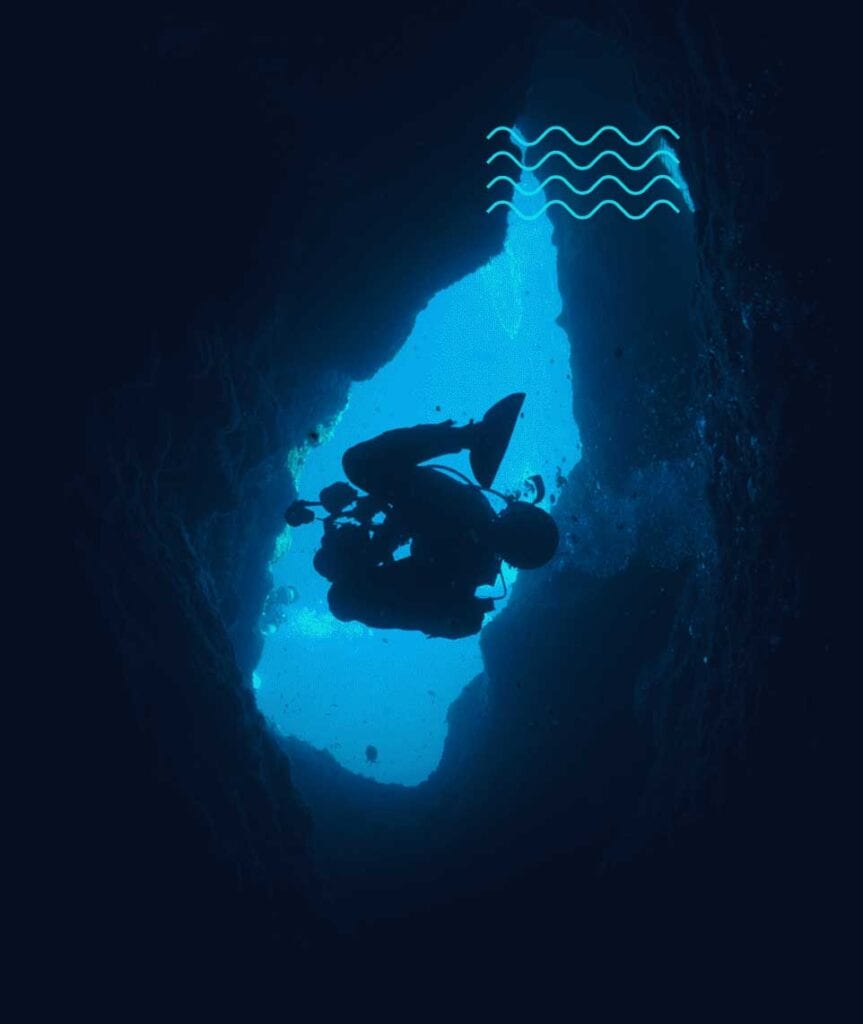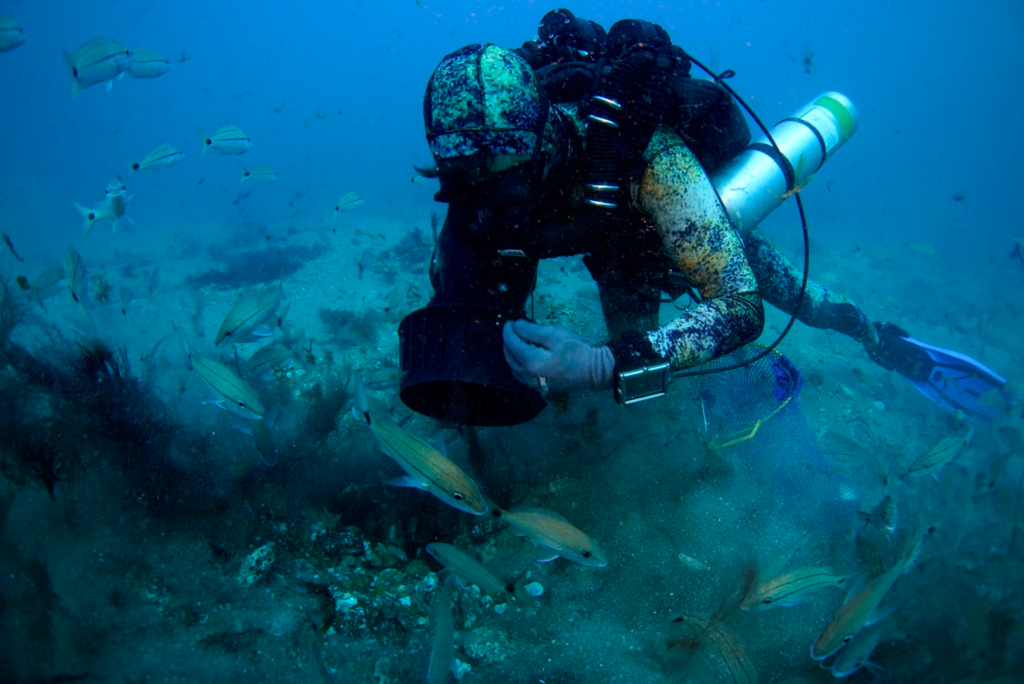Wilmington’s Shark Tooth Divers Thank the Last Ice Age for their Treasure Trove

The following is an article by Daniel Hentz posted to Oceanus, The Journal of Our Ocean Planet
There was only 15 minutes.
That’s how much time diver Chris Slog’s safety margin would allow him while he probed one of North Carolina’s underwater ledges, nearly 115 feet below the ocean’s surface. Tethered to the terminus of his boat’s anchor, he scans the area ahead until he arrives at a rough patch of gravel and debris. From there, he works quickly and flips over his dive scooter—a personal underwater propulsion system—converting it into a deep-sea leaf blower to clear away sediment.
A plume of sand enshrouds him along with a frenzy of pin fish, which descend to eat some of the marine invertebrates that are unearthed by the excavation. Suddenly, his hands reach a slab of limestone about the size of a pizza box. Lifting it up gently, Slog finds it: a pristine, five-inch-long megalodon shark tooth.
“When you find one, you’ll curse through your regulator for sure!” Slog says, excitedly.
The coastal waters in Onslow Bay, North Carolina are perhaps one of the United States’ great megalodon tooth epicenters. Dozens of underwater ledges, like the one Slog dove on above, can be found in a 25-mile stretch across the bay. Many of them are replete with fossilized whale bones, mastodon remains, and of course, the fearsome teeth of the megalodon shark, which went extinct 3.6 million years ago.
Why this predator’s teeth are more available to humans in this area today is in large part thanks to the region’s paleoceanographic past.

“If you were standing in the location of one of the beaches in Onslow Bay millions of years ago, before the ice ages, the sediments from the Oligocene, Miocene, and Pliocene, would’ve been some 100s of meters above your head,” explains WHOI geochemist Konrad Hughen, who studies changes in the ocean’s geologic and paleoclimate records.
The seafloor slope that leaves Onslow Bay into deeper water is a virtual layer cake of fossils. Near the surface are the most recent epochs, during which the megalodon reigned as the ocean’s top predator. Those eras, the Miocene and Pliocene, together span 23 to 2.5 million years ago. Back then, the near-60-foot shark hunted whales voraciously, and its teeth seemed to rain down to the seafloor without end. As time passed, however, a new layer of sediments would bury this trove. Then came the ice ages.
When seawater became locked away and then released from stores of polar ice, North Carolina’s paleo-coastline would move. At the water’s edge, crashing waves chipped away at Onslow Bay’s sloping seafloor, exposing older fossil layers where Slog and Garner can now bring divers.
“When sea levels dropped, it cut down through all of these [prehistoric layers],” says Hughen. “It’s a bit like a caterpillar eating at a leaf.”
The remainders from this process are the sturdier limestone scarps or ledges, which now shield gravel and fossils from strong currents.
“This is like a baffle in a sluice for gold-mining,” adds Hughen. “All of this stuff is trying to gently, slowly wash down the slope and then you have a cut or ledge where it collects.”
According to Slog, only in the past 10 to 15 years have divers discovered they could charter sport-fishing boats in Wilmington to find megalodon teeth. Most vessels would bring them to a popular area, nicknamed “Meg Ledge,” found in the infamous Frying Pan Shoals, which is landmarked by a since-abandoned Coast Guard Watch Tower 40 miles from shore.
After running a friend’s charter vessel in college, Slog, and his business partner Brett Garner, realized they could commercialize guided dive trips to new ledges. In 2017, they established Wrightsville Beach Divers and shark tooth wholesaler, the Fossil Exchange. Their boat, the aptly named “Ledge Tender,” is one of the only known charters in North Carolina that exclusively books shark tooth dives.

“When we were in college, there was really only one spot that everyone would go to,” says Slog. “We’ve kind of found the recipe for where teeth should be and then it’s just a matter of diving there.”
Today, Slog and Garner use a commercial-grade bottom finder to mark these distinct geological features. Over time, they’ve amassed dozens of secret waypoints where they can bring their clients to find teeth. What they dig up for themselves they polish and sell to jewelers, fossil collectors, and museums from their Fossil Exchange website. In any given year, the pair say they sell as many as 6,000 teeth, some worth thousands of dollars. Still, Slog says, consumer demand for shark teeth may never match the thrill of finding them in-person.
Ledge diving is no cake walk for even advanced divers. Visibility can vary from 100 feet to near blackout conditions during a dive, while risks associated with decompression illness increase with bottom time and limited air. Add to that the distracting elation that comes with finding a tooth and it can be easy for tooth-diving to become dangerous.

For Slog and divers like him, that risk makes shark tooth diving no less exhilarating than any other form of artifact hunting at sea. The only difference here may be the science that makes these discoveries possible.
“It’s a big ocean, but where the teeth are is so specific,” says Slog. “It’s something you can’t do everywhere.”
